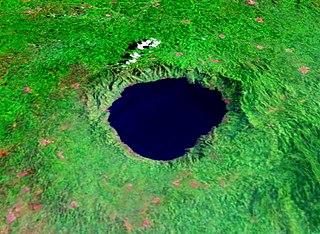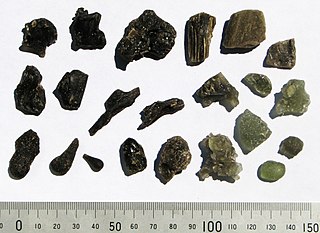 W
WAmguid is a meteorite crater in Algeria.
 W
WLake Bosumtwi is the only natural lake in Ghana. It is situated within an ancient impact crater that is about 10.5 kilometres (6.5 mi) in diameter. It is about 30 km (19 mi) south-east of Kumasi the capital of Ashanti and is a popular recreational area. There are about 30 villages near crater lake Lake Bosumtwi, with a combined population of about 70,000 Ashanti people. The most popular amongst the villages where tourists usually settle is Abono.
 W
WDarwin Crater is a suspected meteorite impact crater in Western Tasmania about 26 km (16 mi) south of Queenstown, just within the Franklin-Gordon Wild Rivers National Park. The crater is expressed as a rimless circular flat-floored depression, 1.2 km (0.75 mi) in diameter, within mountainous and heavily forested terrain. It is east of the West Coast Range and the former North Mount Lyell Railway formation.
 W
WDarwin glass is a natural glass found south of Queenstown in West Coast, Tasmania. It takes its name from Mount Darwin in the West Coast Range, where it was first reported, and later gave its name to Darwin Crater, a probable impact crater, and the inferred source of the glass.
 W
WHiawatha Glacier is a glacier in northwest Greenland, near Inglefield Land. It was mapped in 1922 by Lauge Koch, who noted that the glacier tongue extended into Lake Alida. Hiawatha Glacier attracted attention in 2018 because of the discovery of a crater beneath the surface of the ice sheet in the area. A publication noted in 1952 that Hiawatha Glacier had been retreating since 1920.
 W
WHiawatha Glacier is a glacier in northwest Greenland, near Inglefield Land. It was mapped in 1922 by Lauge Koch, who noted that the glacier tongue extended into Lake Alida. Hiawatha Glacier attracted attention in 2018 because of the discovery of a crater beneath the surface of the ice sheet in the area. A publication noted in 1952 that Hiawatha Glacier had been retreating since 1920.
 W
WThe Hickman crater is a recently discovered meteorite impact crater, 16 kilometres northeast of the Hope Downs 4 Mine and 35 kilometres north of Newman in the Ophthalmia Range, Western Australia. It was discovered by Arthur Hickman, a government geologist with the Geological Survey of Western Australia, in July 2007. The discovery was made by chance while browsing Google Earth. A 2012 government scientific drilling project in the centre of the crater confirmed in 2017 the impact of an iron-nickel meteorite.
 W
WIturralde Crater is an 8-kilometre (5.0 mi) diameter circular geophysical feature in Madidi National Park in the Bolivian portion of the Amazon Rainforest, first identified from Landsat satellite imagery in 1985. The structure is located in a remote area in the Abel Iturralde Province of La Paz Department and was visited by researchers in 2002. Based on the presence of millions of glass beads, it has been hypothesised that the structure was created in the Late Pleistocene by the air burst of a non-impacting meteorite, similar to the Tunguska event in 1908.
 W
WLonar Lake, also known as Lonar crater, is a notified National Geo-heritage Monument, saline, soda lake, located at Lonar in Buldhana district, Maharashtra, India. Lonar Lake was created by an asteroid collision with earth impact during the Pleistocene Epoch. It is one of the four known, hyper-velocity, impact craters in basaltic rock anywhere on Earth. The other three basaltic impact structures are in southern Brazil. Lonar Lake has a mean diameter of 1.2 kilometres (3,900 ft) and is about 137 metres (449 ft) below the crater rim. The meteor crater rim is about 1.8 kilometres (5,900 ft) in diameter.
 W
WMeteor Crater is a meteorite impact crater approximately 37 miles (60 km) east of Flagstaff and 18 miles (29 km) west of Winslow in the northern Arizona desert of the United States. The site was formerly known as the Canyon Diablo Crater and fragments of the meteorite are officially called the Canyon Diablo Meteorite. Scientists refer to the crater as Barringer Crater in honor of Daniel Barringer, who was first to suggest that it was produced by meteorite impact. Because the United States Board on Geographic Names recognizes names of natural features derived from the nearest post office, the feature acquired the name of "Meteor Crater" from the nearby post office named Meteor.
 W
WThe Odessa Meteor Crater is a meteorite crater in the southwestern part of Ector County, southwest of the city of Odessa of West Texas, United States. It is accessible approximately 3 mi (5 km) south of Interstate 20 at Exit 108. This is one of three impact crater sites found in Texas, the others being the older and much larger Sierra Madera crater and the Marquez crater.
 W
WThe Pingualuit Crater, formerly called the "Chubb Crater" and later the "New Quebec Crater", is a relatively young impact crater located on the Ungava Peninsula in the administrative region of Nord-du-Québec, in Quebec, Canada. It is 3.44 km (2.14 mi) in diameter, and is estimated to be 1.4 ± 0.1 million years old (Pleistocene). The crater and the surrounding area are now part of Pingualuit National Park. The only species of fish in the crater lake is the Arctic char.
 W
WThe Río Cuarto craters are a purported group of impact craters located in Córdoba Province, Argentina. Research published in 2002 indicates that they are more likely a result of Aeolian processes.
 W
WTenoumer is considered to be an impact crater in Mauritania.
 W
WTswaing is an impact crater in South Africa that is accompanied by a museum. It is situated 40 km to the north-west of Pretoria. This astrobleme is 1.13 km in diameter and 100 m deep and the age is estimated to be 220,000 ± 52,000 years (Pleistocene). The impactor is believed to have been a chondrite or stony meteorite some 30 to 50 m in diameter that was vapourised during the impact event. Morokweng crater, another crater of chondrite origin, lies north-west of Vryburg.
 W
WVeevers crater is an impact crater located on a flat desert plain between the Great Sandy and Gibson Deserts in the center of the state of Western Australia. The site is very remote and difficult to visit. The crater was discovered from the air in July 1975 during a government geological survey and named in honor of Australian geologist John Veevers who had worked in the area in the late 1950s. At the time of discovery a meteorite impact origin was suspected, but could not be proven. The subsequent discovery of iron meteorite fragments around the crater by E.M. and C.S. Shoemaker in 1984 removed any doubt about its origin.
 W
WWolfe Creek Crater is a well-preserved meteorite impact crater (astrobleme) in Western Australia.
 W
WZhamanshin is a meteorite crater in Kazakhstan. It is 14 kilometres (8.7 mi) in diameter and the age is estimated to be 900,000 ± 100,000 years (Pleistocene). The crater is exposed at the surface.